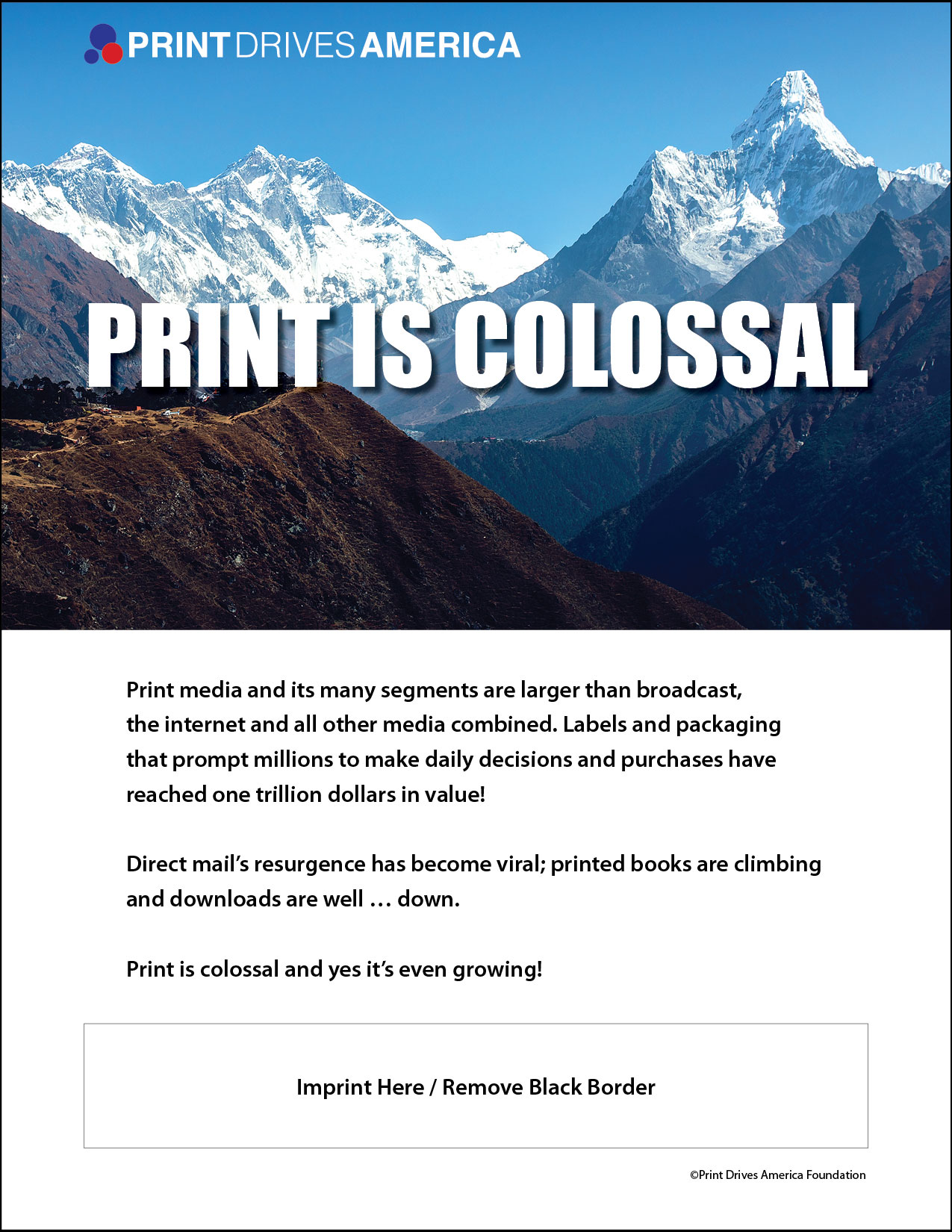By Gary A. Jones, Director, EHS Affairs, Printing United Alliance (gjones@printing.org)
The spread of the coronavirus (COVID-19) has had an unprecedented impact on printing operations ranging from interrupting business flow, disrupting supply and delivery chains, upsetting financial markets, disrupting travel plans, and forcing the cancellation of meetings and events. It has also impacted employees causing absenteeism and forcing many into teleworking.
In response to growing concerns regarding COVID-19, the Occupational Safety and Health Administration (OSHA) recently issued guidance to employers concerning their regulatory obligations to keep workplaces safe during the current COVID-19 pandemic. OSHA’s guidance includes information on the ways COVID-19 can spread, which includes between people who are in close contact (within about 6 feet) and through respiratory droplets produced when an infected person coughs or sneezes.
OSHA Requirements
OSHA does not have a specific regulation addressing COVID-19. This does not mean that printing operations are exempt from OSHA compliance in the face of the COVID-19 outbreak. OSHA has identified several regulations that would apply due to the risk and presence of coronavirus in the workplace and they include:
- General Duty Clause [Section 5(a)(1) of the OSH Act, 29 U.S.C. § 654(a)(1)] This requires employers to furnish to each worker “employment and a place of employment, which are free from recognized hazards that are causing or are likely to cause death or serious physical harm.” OSHA may cite an employer under the general duty clause if the employer allows or directs a known infected employee to come to work and expose other employees to the risk of infection.
- Personal Protective Equipment (29 CFR 1910.132)These standards may require using gloves, eye and face protection, and respiratory protection, among other things, in appropriate circumstances. Use of N95 or other respirators require implementation of a comprehensive program including a written program, medical evaluation, fit testing, maintenance, employee training etc.
- Hazard Communication Standard (29 CFR 1910.1200)This standard requires employers to provide training on chemical hazards, safe handling, and protection measures for employees exposed to hazardous chemicals such as those being used for cleaning and disinfection.
- Sanitation (29 CFR 1910.141) This standard requires all places of employment to be kept clean to the extent that the nature of the work allows.
- Bloodborne Pathogens Standard (29 CFR 1910.1030) This standard applies occupational exposure to human blood and other potentially infectious materials that typically do not include respiratory secretions that may transmit COVID-19. However, the provisions of the standard offer a framework that may help control some sources of the virus, including exposures to body fluids (e.g., respiratory secretions) not covered by the standard.
[Print & Graphic Communications Association members have access to free recorded webinars on these subjects, available on demand. For more information, visit https://printcommunications.org/safety-webinars/]
Recording and Reporting COVID-19 Incidents
Under OSHA’s recordkeeping regulations printing operations are required to record certain illnesses on OSHA Form 300. While the recordkeeping regulations generally exempt the “common cold and flu,” COVID-19 is not considered a common cold or flu. OSHA’s initial position when it issued it guidance for workplaces on COVID-19, they stated “COVID-19 can be a recordable illness if a worker is infected as a result of performing their work-related duties.”
In a clarification to its initial position, OSHA is now going to exercise its enforcement discretion regarding the need for many establishments, including printing operations, to record cases of COVID-19 infections in its workforce. Initially when the coronavirus pandemic began, OSHA maintained its historic position that if an employee contracted the virus and became ill at work, the employer would be required to make a determination that it was work related and if so determined, it needed to be recorded as an illness on OSHA Form 300. The other conditions of recordability included confirmation that the illness was COVID-19 and the employee missed work, or became hospitalized, or was sent home for quarantine, and could not otherwise perform their duties from home.
On Friday April 10, 2020 OSHA issued interim guidance with no expiration date for enforcing OSHA’s recordkeeping requirements (29 CFR Part 1904) as it relates to recording cases of COVID-19. Under the interim guidance, printing facilities will not be required to report coronavirus cases among their employees because companies “may have difficulty making determinations about whether workers who contracted COVID-19 did so due to exposures at work.”
OSHA’s guidance does provide an exception in which recording a COVID-19 illness would be required. An employer must record a COVID-19 illness when:
- There is objective evidence that a COVID-19 case may be work-related. This could include, for example, a number of cases developing among workers who work closely together without an alternative explanation; and
- The evidence was reasonably available to the employer. For purposes of this memorandum, examples of reasonably available evidence include information given to the employer by employees, as well as information that an employer learns regarding its employees’ health and safety in the ordinary course of managing its business and employees.
This enforcement policy will help employers focus their response efforts on implementing sanitation and other good hygiene practices in their workplaces rather than on making difficult work-relatedness decisions in circumstances where there is community transmission. PRINTING United Alliance has developed a sanitation guide to aid printing operations in their sanitation efforts.
On October 1, 2020, OSHA published additional frequently asked questions and answers (FAQs) regarding the need to report employees’ in-patient hospitalizations and fatalities resulting from work-related cases of the coronavirus. In this updated document, the OSHA provides guidance on how to calculate reporting deadlines for in-patient hospitalizations and fatalities and clarifies the meaning of the term “incident” as it relates to work-related coronavirus in-patient hospitalizations and fatalities.
The FAQs are the latest effort by OSHA to provide employers and employees with more information about how it will enforce its standards and regulations during the pandemic. OSHA also previously published revised enforcement guidance detailing how OSHA will enforce the recordkeeping requirements of 29 CFR 1904 for employee coronavirus illnesses for all employers. While FAQs are not binding from a regulatory perspective, they provide guidance and represent the latest thinking by OSHA.
The good news is that the new FAQs are more consistent with OSHA’s regulations governing injury and illness reporting. The new FAQs provide the following changes for reporting purposes:
- A “work-related incident” is defined as “an exposure to SARS-CoV-2 in the workplace.” A May 19, 2020 OSHA Memorandum outlines the inquiry the company should use to make the determination of the exposure happened at work.
- Hospitalizations must be reported within 24 hours from the time of the on-the-job exposure and subsequent hospitalization. The report must be made within 24 hours of the employer becoming aware that the employee was hospitalized due to the exposure and the exposure was work-related.
- A fatality must be reported within 8 hours if it occurs within 30 days from an on-the-job exposure or work-related exposure.
The revised FAQs provide much more clarity regarding when COVID-19 work related exposures occur. If an employee becomes infected with the virus, employers now need to determine if the exposure was work related and the date and time of exposure in addition to the fate of the employee as this information will dictate what reports need to be filed with OSHA.
Remote Workers
Many printing operations are allowing or encouraging employees to telecommute, and OSHA does have requirements for home-based workers. OSHA does distinguish between home offices, areas of an employee’s home in which an employee conducts office work activities such as answering phone calls, research, reading, and writing, and home-based worksites, areas of an employee’s home where the employee “performs work of the employer” such as home manufacturing operations.
Since home offices are the more typical current telework scenario, OSHA has reiterated its policy that it will not conduct at-home workplace inspections and that it will generally not hold employers liable for at-home safety issues. However, employers’ other health and safety obligations remain intact, even for remote employees. Employers also retain responsibility for hazards caused by materials, equipment, or work processes the employer provides or requires to be used in an employee’s home.
In the case of an injury sustained at home, OSHA will consider an injury “work-related” if it both occurs while the employee is performing work for pay in their home and is directly related to the performance of work, rather than to the general home environment or setting. Employers are thus required to keep records of work-related injuries (and update their OSHA Form 300 logs) that otherwise meet the recordability criteria suffered by remote workers. So, employers should encourage all remote employees to report workplace injuries and unsafe working conditions and notify them of the procedures to do so.
Anti-Retaliation
Due to the constant influx of news and information and occasional misinformation that employees may be hearing, reading, or discussing, employers should keep in mind the OSH Act’s anti-retaliation provision. This provision prohibits employers from retaliating against workers for raising concerns about safety and health conditions. OSHA’s current position is that most workers remain at a low risk for exposure. Therefore, maintaining a calm presence in the face of employee concerns will help alleviate anxiety and provide reassurances to worried workers helping to avoid a potential retaliation claim.
Workplace Actions
Given broad scope of the general duty clause and other regulations, OSHA’s COVID-19 Guidance provides a suite of recommendations to assist employers in assessing risk and determining appropriate planning, prevention, and control measures in the workplace.
While each printing operation must tailor their response to their specific workplace, the following are actions that should be implemented:
- Encourage all employees who are experiencing COVID-19 symptoms to inform their supervisor.
- Create a policy to prevent employees infected with COVID-19 to stay away from work until they are no longer infected.
- Have employees practice social distancing, defined as being 6 feet away from each other, while at work.
- Encourage employees to frequently wash their hands and provide information on proper hand washing. “Wash your hands often with soap and water for at least 20 seconds, especially after going to the bathroom; before eating; and after blowing your nose, coughing, or sneezing.”
- Encourage employees to not touch their face eyes, nose or mouth.
- Provide hand sanitizer and encourage employees to use it when they can’t wash their hands.
- Provide tissues, trash receptacles or other hygiene products.
- Provide information on how to properly cover their cough or sneeze with a tissue or use the inside of your elbow, then throw the tissue in the trash followed by washing their hands.
- Discourage employees from shaking hands, hugging or engaging in other personal contact.
- Prepare and hang posters that encourage proper hygiene practices.
- Clean and disinfect frequently touched objects and surfaces using EPA identified disinfectant sprays or wipes.
As printing operations implement their COVID-19 response plans and policies, additional examples provided in the COVID-19 OSHA Guidance may be helpful. Employers also should consider and incorporate guidance from other agencies such as the CDC, which has best practices for employers to mitigate and handle exposure to COVID-19 in the workplace and state and local health agencies.
Summary and Conclusion
The events of the past several weeks have shown that COVID-19 is impacting printing operations and its workforce. Printing companies that are continuing operations must implement policies and procedures designed to protect employees from contracting COVID-19 in the workplace. OSHA’s COVID-19 Guidance is a useful tool to design approaches to mitigate the current situation and to protect the safety of its employees.
PIA Safety Training Resources
Print & Graphic Communications Association members have access to free recorded webinars on 17 mandatory and recommended subjects, including a webinar on OSHA Recordkeeping to assist in completing the OSHA log. Visit https://printcommunications.org/safety-webinars/ for details and contact PIA staff at info@printcommunications.org for assistance.




